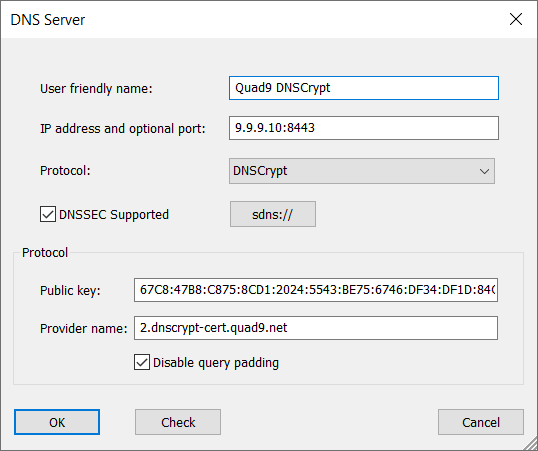

- #How to use dnscrypt for windows how to
- #How to use dnscrypt for windows windows 7
- #How to use dnscrypt for windows download
- #How to use dnscrypt for windows windows
That means, MakeService, and dnscrypt-proxy.exe. With MakeService, the commands would be simple. I've restored MakeService, but another (perhaps better) option is ServiceEx, also freeware and command line based. If you can't find one you like, I can provide my old freeware utility. Still, there are plenty of freeware utilities that will allow you to set this up. I used to distribute a utility that allowed this, MakeService, though later removed it after it was abused by malware authors.

This is necessary so that a user need not log in for your DNS resolution to work.
#How to use dnscrypt for windows windows
I *strongly* recommend setting this dnscrypt-proxy.exe process to start automatically as a Windows Service. Setting up dnscrypt-proxy.exe to run Automatically as a Windows Service If you were using OpenDNS before, then this last test is not valid. If you aren't, then it will tell you that you aren't. If you are using OpenDNS, it will tell you that you are. To be triple sure, try the OpenDNS test URL. Restart the dnscrypt process, and everything should now WORK. If it fails, then all is good! If it *succeeds* then you still have plaintext DNS queries being resolved and will need to double check your configuration. Now see if some domain you've not visited anytime recently *fails* to resolve by trying a ping, or just visiting their web site. Doing an 'inverse test' is superior to doing a 'working test' because it ensures there is no unencrypted (standard) DNS resolution available. The idea is to make sure that you can now NOT resolve DNS queries. Clear your DNS cache with by running ' ipconfig /flushdns'. To test, first SHUT DOWN the OpenDNS dnscrypt process (dnscrypt-proxy.exe). You'll see something like this:Īfter that, it should work. Go to your Network Connections, right click the Local Area Connection (or whichever you are using), and select 'Properties'. Since Windows is dual-stack, you *must* remember to change the IPv6 DNS configuration as well, to the local loopback (::1). So, the next step is to *change* your DNS configuration to point to your local PC, since it now has a DNS server running on it (127.0.0.1 in IPv4, or ::1 in IPv6). Once started, it sets up a local proxy server that will resolve DNS queries for you, through an encrypted connection to the OpenDNS server closest to you. There are numerous tools to run normal applications as a service, and numerous ways to start it on boot, so I'll let the reader work on that. Now, you'll want to set it to start at boot, or even run as a service.

#How to use dnscrypt for windows windows 7
I've tested it on Windows 7 圆4.Įxtract it somewhere.
#How to use dnscrypt for windows download
Once you download it, you'll see it is a single 32-bit EXE, though will work fine on Windows 圆4. This is all at your own risk, though I'm sure nothing dangerous is coming from OpenDNS's GitHub repository ). I actually had a false positive when I downloaded it, so if you see such with Microsoft Security Essentials, then ignore it - I'm sure it will be fixed soon. In some cases, encrypted DNS queries may get you around site blockers/firewalls too (though not all cases).įirst download the Windows client. Whether it is your ISP, or a local sniffer, if you want privacy, your DNS queries are a glaring hole in it. I just noticed it was there, tried it out - and it works ).Įven if you use HTTPS on every site you visit, your DNS queries are painfully obvious to anyone. I am not sure if it is considered 'final' or not. However, a Windows client is now available for download at their GitHub repository . At first there were only OS X, BSD, and Linux clients available. They've kept fairly quiet about it, though it has been mentioned on Slashdot and elsewhere. OpenDNS has been working on a new encrypted DNS service for the past 6 months or so. URL: hXXp:///2012/03/using-encrypted-dns-with-windows-via.htmlĬOPY of blog post (formatting will be terrible): Of course, people can still see where traffic is going, but this is at least an improvement. By encrypting them, you are that much safer. These queries resolve domain names into IP addresses, and thus reveal every domain you intend to visit each time one is made. DNS query resolution is perhaps the largest, most glaring, open 'issue' if you're concerned about your internet browsing privacy. It was previously only available on OS X, BSD, and Linux, but I happened to notice a Windows client - which seems to work just great.
#How to use dnscrypt for windows how to
I wrote up this blog post, showing how to easily start using OpenDNS's new encrypted DNS service on Windows.


 0 kommentar(er)
0 kommentar(er)
